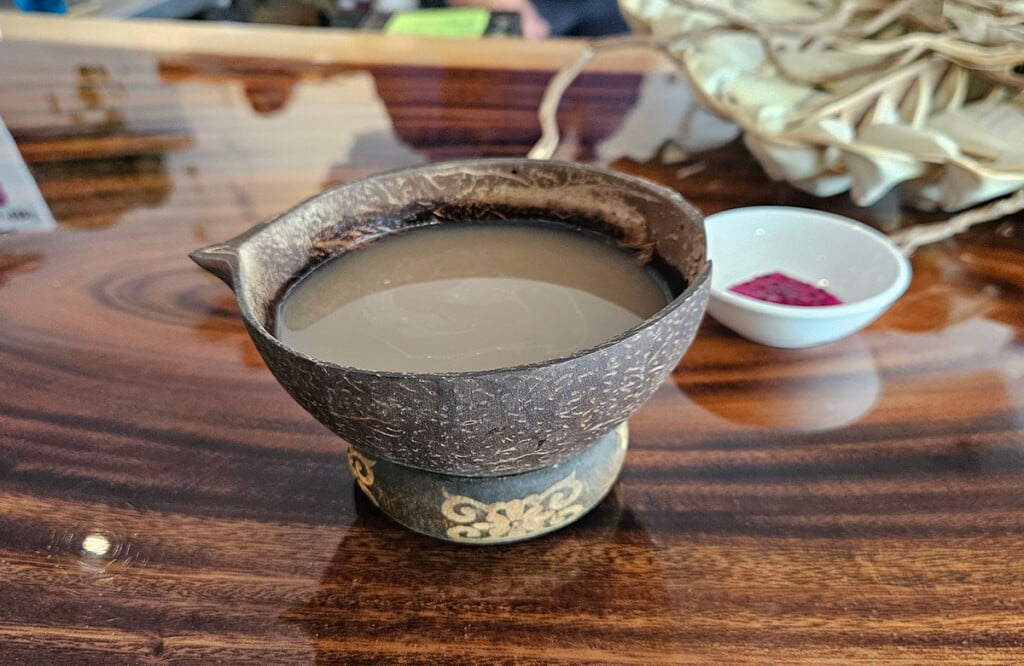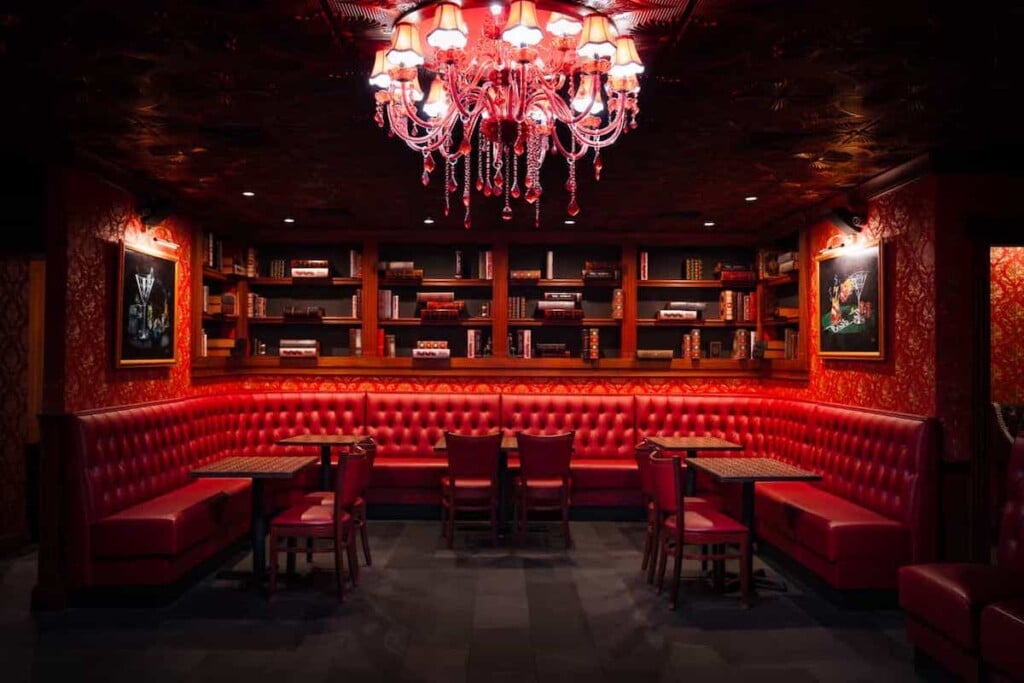Walk Inside the Controversial Telescopes Atop Mauna Kea Starting This Month
New free tours of observatories aim to show a symbiotic relationship between culture and science on this sacred mountain.

Photos: Catherine Toth Fox
Luahiwa Nāmāhoe’s father had always told her that she needed to make up her own mind about things.
So when the Maunakea Observatories and the ‘Imiloa Astronomy Center partnered to offer free monthly tours of the world-class telescopes atop the sacred mauna starting this month, she quickly signed up.
As the granddaughter of the late Genesis Namakaokalani Lee Loy, the founder of the Hawaiian sovereignty movement on Hawai‘i Island who protested NASA’s plan to build “outrigger” telescopes around the two giant Keck telescopes on Mauna Kea, Nāmāhoe needed to see them for herself.
“These telescopes have always been ethereal to me, and I’ve never formed an attachment to them,” says Nāmāhoe, 47, an account manager for HMSA in Hilo and self-described “STEM (science technology engineering and mathematics) geek,” who participated in the tour Saturday wearing a navy blue NASA sweatshirt. “To me, the most impactful thing was access. This [tour] has allowed me to have the opportunity to feel a sense of ownership and a sense of place. It was a privilege.”
That’s the goal of the new program, called the Kamaʻāina Observatory Experience—the first of its kind—which gives Hawai‘i residents a chance to tour inside the telescopes that dot the landscape of one of the most revered sites in the Islands.
While the telescopes that make up the Maunakea Observatories collaboration of independently run telescopes have been talking about a tour like this for years, the heated protests last year against the building of the $1.4 billion Thirty Meter Telescope, or TMT, created more urgency to get it done.
“I’ve been preaching the gospel that the observatories on Mauna Kea are the melding of three elements—culture, environment and science,” says Doug Simons, the executive director of the Canada-France-Hawai‘i Telescope who has lived in Hawai‘i for 30 years. “Fast forward to last year and the TMT conflict that erupted and I haven’t changed my tune at all … For me, Hawai‘i astronomy is my whole life and it’s a story I’m super excited to share through this program.”

Prior to this program, each observatory conducted its own tours of its facility, most often for private groups and schools. Telescopes have been on the mountain for half a century. Yet, this is the first time a group of observatories worked together to create a coordinated program that emphasizes both the cultural and scientific importance of Mauna Kea, with guided tours of two of the 13 telescopes. (The telescopes that participate will rotate every month.) The monthly tour, which can accommodate only 24 people now, is free and open to kamaʻāina 16 years and older, with lunch and transportation provided from the Maunakea Visitor Information Center.
The tour on Saturday started at 10 a.m. with a quick ride in passenger vans from the visitors center to Hale Pōhaku, a collection of support facilities—dorms, a cafeteria, a lounge with pool tables and dart boards—for the people who work at the telescopes. Here, at 9,300 feet above sea level, we could acclimate to the elevation, which would near 14,000 feet by the time we arrived at the observatories.
Simons welcomed the participants, many of whom reside on Hawai‘i Island. Then kumu hula Micah Kamahoali‘i, whose family has lived in Waimea for “100 generations,” opened with an oli (chant) and shared the cultural significance of and mo‘olelo (stories) about this revered volcano. It’s the central element of Native Hawaiian creation stories, the first-born mountain son of Wākea and Papa, and the connection between the land and the heavens. The summit, which rises 13,796 feet above sea level, making it the tallest island volcano and highest peak in all of Oceania, is the most sacred part of Mauna Kea. It’s considered wao akua, or the realm of the gods.
“We have to learn how to live in the same world with both science and culture,” says Kamahoali‘i, whose family owned a janitorial business that was contracted by some of the observatories. “This is something the community needs, and it’s finally happening. My biggest thing is that we know our place, we know our space, and we know how to live in two spaces. I always say, ‘Walk in the footsteps of our kūpuna but wear shoes this time.’”

Photos: Catherine Toth Fox
After a discussion on safety, which included what not to do in the 10,300-acre Maunakea Science Reserve—don’t go off-trail, don’t stack rocks—we were briefed on high-altitude hazards, such as dehydration, intense solar radiation and altitude illness, which can lead to life-threatening conditions such as high-altitude pulmonary edema and high-altitude cerebral edema.
“There’s 40 percent less oxygen up there than you’re used to,” said Joy Pollard, who works in outreach for the Gemini Observatory. “It’ll feel like you’ve had a cocktail or two … Most people don’t get sick, but almost everyone feels something.”
At around noon, we moved to the cafeteria for lunch. Saturday’s menu featured seared ‘ahi, teriyaki beef, egg foo young, white rice, crinkle-cut french fries, salad and fruits. There were even four different flavors of ice cream—chocolate, vanilla, strawberry and mint chocolate chip—to choose from, in your choice of a sugar cone or bowl. (We were advised earlier not to overeat, since digestion uses some oxygen and you need all the oxygen you can get at higher elevations.)

After a half-hour lunch, we walked outside and threw Hawaiian salt over ourselves in a traditional ritual of cleansing before loading into the vans for the 30-minute drive to the summit.
The winding, somewhat-paved road to the top—a four-wheel drive vehicle is required—offers some of the most stunning views of Hawai‘i Island. As we drove through the alpine region of Mauna Kea, we saw healthy māmane trees, an important habitat for the critically engandered golden-headed palila (a finch-billed species of Hawaiian honeycreeper) that relies on the seeds from this tree. We came across the extremely rare Mauna Kea silversword, or ‘āhinahina, a giant rosette plant found only in this area of Mauna Kea. And below us were sweeping, panoramic views of the island. We could see steam rising from the active Puʻu ʻŌʻō, the massive neighboring volcano Mauna Loa and the 10,000-foot peak of Maui’s Haleakalā in the distance.
At the summit, and after a few people were outfitted with oxygen tanks to prevent altitude sickness, we spent about two hours touring both the Gemini Observatory and the Canada-France-Hawai‘i Telescope. The newer Gemini, established in 2000, consists of twin 8.1-meter telescopes—Gemini North is here, Gemini South is in Chile—operated by a partnership of five countries. Together, these two telescopes provide almost complete coverage of both northern and southern skies and boast one of the most advanced optical/infrared telescopes in the world. The older CFHT, in operation since 1979, houses a 3.58-meter optical/infrared telescope and operates four instruments, including the new, multimillion-dollar SITELLE, an optical imaging Fourier transform spectrometer.

The guides—all working scientists and engineers—walked us through the facilities and control rooms, explaining instruments and discussing the research that’s being done here.
And this research isn’t just to discover new solar systems or answer the lofty question, “Are we alone in the universe?” Astronomy is responsible for everday technology we often take for granted, such as the iPhone camera and GPS.
While some of it was difficult for anyone without an astromony degree to understand, it was obvious that these people were passionate about their research and science.
“We want to show people who live here what we do, to pull back the curtain on some of the mystique here and give them ownership of the observatories,” says Mary Beth Laychak, CFHT outreach program manager. “We really can’t do this work without the local community.”
The experience was introduced in October 2015 during a speech by President Barack Obama at the White House Astronomy Night in Washington, D.C.
The Kamaʻāina Observatory Experience is offered every third Saturday for residents only. Participants must be 16 years or older and possess a valid Hawai‘i ID. The free tour runs from 10 a.m. to 4 p.m. and includes lunch. The tour is capped at 24 participants and reservations are on a first-come, first-served basis. Participating observatories are the Canada-France-Hawai‘i Telescope, Gemini Observatory, the James Clerk Maxwell Telescope (EAO), NASA Infrared Telescope Facility, Subaru Telescope, Submillimeter Array and the W.M. Keck Observatory. For more information about the tour or to reserve a spot for an upcoming tour, visit kamaainaobservatoryexperience.org or call the ‘Imiloa Astronomy Center at (808) 969-9703.
READ MORE STORIES BY CATHERINE TOTH FOX








